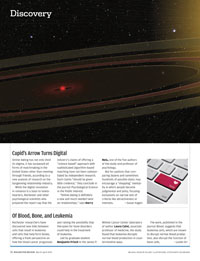Discovery
 (Photo: Michael Osadciw)
(Photo: Michael Osadciw)Scientists Discover ‘Saturn on Steroids’
An unusual eclipse in a constellation roughly 420 light years away is offering the first glimpse of a planetary ring system outside the solar system. Led by Eric Mamajek, assistant professor of physics and astronomy, an international team discovered the extrasolar planetary system while tracking patterns of light in the Centaurus constellation, part of a massive star formation between 380 to 470 light years from the sun. Using data from SuperWASP (Wide Angle Search for Planets) and All Sky Automated Survey (ASAS), the researchers noticed that the light pattern from one star in the cluster showed dramatic changes over a 54-day period in early 2007. Rochester graduate student Mark Pecaut and Mamajek identified the pattern as consistent with a protoplanetary disk—similar to that of Saturn—passing in front of the star, dimming its light accordingly. “After we ruled out the eclipse being due to a spherical star or a circumstellar disk passing in front of the star, I realized that the only plausible explanation was some sort of dust ring system orbiting a smaller companion—basically a ‘Saturn on steroids,’ ” says Mamajek.
—Peter Iglinski
Cupid’s Arrow Turns Digital
 (Photo: iStockPhoto)
(Photo: iStockPhoto)Online dating has not only shed its stigma, it has surpassed all forms of matchmaking in the United States other than meeting through friends, according to a new analysis of research on the burgeoning relationship industry. While the digital revolution in romance is a boon to lonely-hearters, Rochester and other psychological scientists who prepared the report say that the industry’s claims of offering a “science-based” approach with sophisticated algorithm-based matching have not been substantiated by independent research. Such claims “should be given little credence,” they conclude in the journal Psychological Science in the Public Interest. “Online dating is definitely a new and much needed twist on relationships,” says Harry Reis, one of the five authors of the study and professor of psychology. But he cautions that comparing dozens and sometimes hundreds of possible dates may encourage a “shopping” mentality in which people become judgmental and picky, focusing exclusively on narrow sets of criteria like attractiveness or interests.
—Susan Hagen
Of Blood, Bone, and Leukemia
Rochester researchers have discovered new links between cells that result in leukemia and cells that help form bones, offering a fresh perspective on how the blood cancer progresses and raising the possibility that therapies for bone disorders could help in the treatment of leukemia. Led by graduate student Benjamin Frisch in the James P. Wilmot Cancer Center laboratory of author Laura Calvi, associate professor of medicine, the study found that leukemia disrupts normal blood production in counterintuitive ways. The work, published in the journal Blood, suggests that leukemia cells, which are known to disrupt normal blood production, also disrupt the function of bone cells.
—Leslie Orr
Starve a Virus, Feed a Cure?
A new finding indicates that a protective protein in some of our immune cells may be an important key to fighting HIV and may provide important clues to understanding how other viruses elude our body’s defenses. Publishing online in Nature Immunology, the international team including Medical Center scientists report that the protein seems to block the ability of HIV to replicate by starving the virus of the molecular building blocks that it needs to replicate. Baek Kim, professor of microbiology and immunology and one of three corresponding authors of the paper, says the findings may explain why certain anti–HIV drugs used today are more effective under some circumstances than others. Researchers hope the work will help lead to a way to make anti–HIV drugs more effective, as well as further research into herpes viruses and other pathogens.
—Tom Rickey
A Pill for Heat Stroke?
 (Photo: iStockPhoto)
(Photo: iStockPhoto)In a study published in the journal Nature Medicine, Medical Center scientists outline what they believe is one of the first drugs to combat heat stroke. An experimental therapy called AICAR—once dubbed the “couch potato pill” for its ability to mimic the effects of exercise in sedentary mice—protected animals that were genetically predisposed to heat stroke from the potentially life-threatening condition. Robert Dirksen, the study’s author and professor of pharmacology and physiology, says the finding is an important first step toward developing a drug therapy that may be part of the standard treatment for heat stroke in the future. According to a recent study in the American Journal of Preventive Medicine, the number of heat-related injuries in the United States more than doubled from 1997 to 2006. In that 10-year period, an estimated 55,000 people were treated for the condition in emergency rooms across the country.
—Emily Boynton

